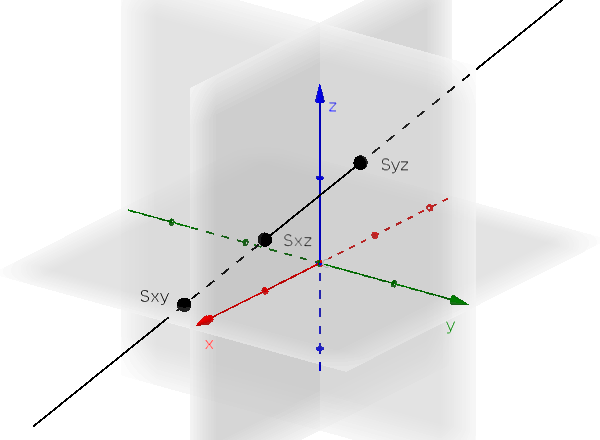Intercepts
The intersections of a line with the coordinate planes $E_{xy}$, $E_{xz}$, $E_{yz}$ are called intercepts.
Remember

Method
- Set corresponding coordinate equal to zero and determine $r$
- Insert $r$ in the linear equation to get the intercepts
Hint
- $E_{xy}: z=0$
- $E_{xz}: y=0$
- $E_{yz}: x=0$
Example
Determine the intercept of the line $g$ with the xy-plane.
$\text{g: } \vec{x} = \begin{pmatrix} 1 \\ 2 \\ 3 \end{pmatrix} + r \cdot \begin{pmatrix} 4 \\ 5 \\ 6 \end{pmatrix}$
-
Determine $r$
Since it is the plane $E_{xy}$, we set z equal to 0.$\begin{pmatrix} x \\ y \\ 0 \end{pmatrix} = \begin{pmatrix} 1 \\ 2 \\ 3 \end{pmatrix} + r \cdot \begin{pmatrix} 4 \\ 5 \\ 6 \end{pmatrix}$
The row with just one variable (the third) has to be solved for $r$.
$0=3+6r\quad|-3$
$-3=6r\quad|:6$
$r=-0.5$ -
Determine intercept
$\text{g: } \vec{x} = \begin{pmatrix} 1 \\ 2 \\ 3 \end{pmatrix} + r \cdot \begin{pmatrix} 4 \\ 5 \\ 6 \end{pmatrix}$
The calculated $r=-0.5$ is used in the linear equation.
$\begin{pmatrix} 1 \\ 2 \\ 3 \end{pmatrix} + (-0.5) \cdot \begin{pmatrix} 4 \\ 5 \\ 6 \end{pmatrix}$ $=\begin{pmatrix} -1 \\ -0.5 \\ 0 \end{pmatrix}$
The intercept with the xy-plane is at $S_{xy}(-1|-0.5|0)$
